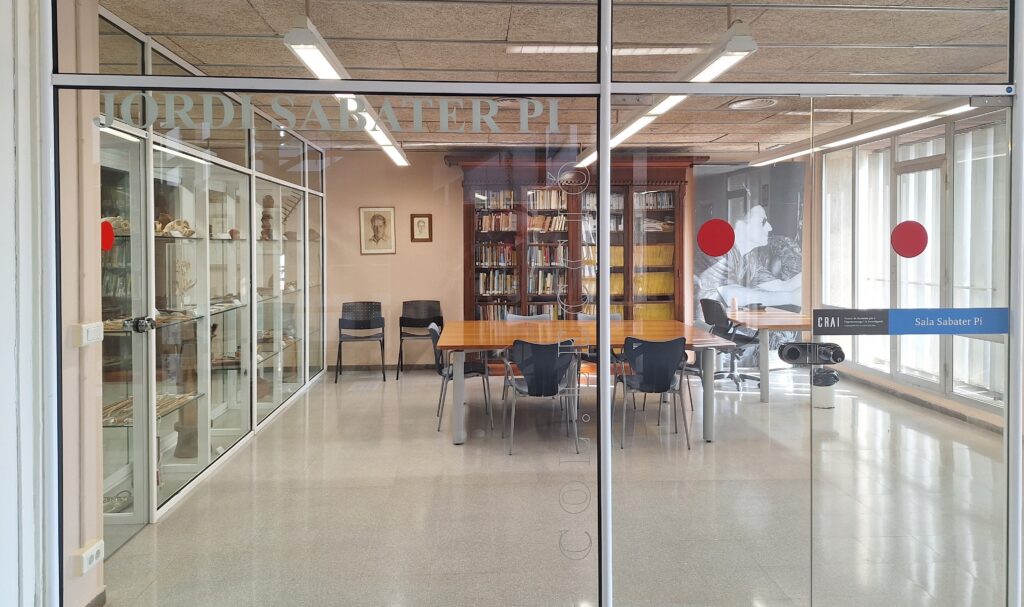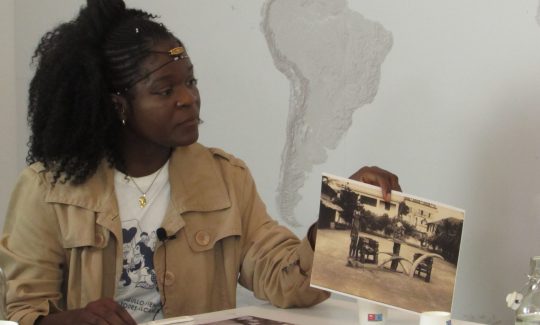Universities, as spaces for reflection and change, offer an opportunity to remember and rethink the colonial past, and to explore new forms of restitution that respect and involve the peoples affected by colonization. This environment allows us to question how a skull, which was part of an ancestral cult, ended up being exhibited in a space at the University of Barcelona.
More than a simple sculpture, the biere is an object loaded with meaning for the descendants of the Fang people, since it is a ritual figure guardian of human remains, used to invoke ancestors through the cult of the dead. A practice of great significance for the Fang community. This cult, known as melan, was passed down from generation to generation, forming an essential part of the cultural identity of this people.
Jordi Sabater Pi and his collection
The figure of the biere that ended up at the University of Barcelona arrived there through Jordi Sabater Pi, a biologist and ethnographer who lived in Equatorial Guinea between 1940 and 1969, where he amassed an important collection of ethnographic objects, including the aforementioned skull. Sabater Pi is known for his involvement in the research and capture of animals, especially the arrival in Barcelona of the famous white gorilla Floquet de Neu, but he was also a central figure in a much less publicized chapter: the study and collection of objects of material culture from the African continent. The acquisition of objects also involved the supply to Europe, including Catalonia, of a large number of cultural objects that belonged to African peoples.
The arrival of these objects in Europe is explained by the colonial context of the time. In the 1920s, under the governance of Núñez de Prado, the colonial authorities and Claretian missionaries began a repression against the Melan culture, considering it savage and trying to suppress it through the destruction of several sacred objects of the Fang people. But, paradoxically, these objects were the ones that aroused the interest of collectors of African art, such as Sabater Pi, for them the biere represented an authentic fragment of the Fang culture, a representation of what they considered African art.
The Jordi Sabater Pi Collection was formally donated to the University of Barcelona in a recognition ceremony held at the Barcelona Science Park in April 2000. At that time, Sabater Pi took charge of the personal cataloguing of the collection, a task he carried out with the assistance of his secretary. Every day, even in the last years of his life, when he was already wheelchair-bound, Sabater Pi personally went to the University to catalog the objects, as well as other ethnological pieces from his vast collection. These tasks continued until his death in 2009.
The collection includes more than 1.500 drawings and watercolors, 5.500 manuscripts, an extensive correspondence, photographs, slides, videos and a wide variety of ethnological objects from Africa, such as the biere. In addition to materials on ethological and primatological topics, there are also collections dedicated to ethnography, botany, philosophy, history and psychology. The collection is a reflection of Sabater Pi’s dedication to research and the preservation of African cultural and natural heritage.
The withdrawal of Essik-Melan biere and its current conservation
Currently, the Sabater Pi collection is kept in a closed room on the first floor of the University’s CRAI, where access can only be granted in the company of one of the librarians. In the room, you can see various elements of the collection, including portraits of Sabater Pi and some of his graphic works. The main display case of the room contains several animal skeletons, such as the goliath frog, and other ethnological objects that are part of this collection. In the past, the biere was also exhibited in this same space, until it was removed for conservation.
The biere of the Fang community, known as Essik-Melan, was removed from the exhibition at the University of Barcelona Library in February 2022 by a decision of the Vice-Rectorate for Heritage and Cultural Activities of the UB. This action led to the figure being removed for restoration and conservation in a closed space. It is currently kept in a conservation box in the same room dedicated to the Sabater Pi collection with the aim of avoiding its public exhibition.
This biere, once considered a sacred object within the Melan cult, ended up being a piece that was decontextualized and exhibited as an exotic element in an academic space. This transition from cultural value to collection value is a testament to the colonial dynamics that allowed the plundering of cultural heritage and its subsequent reconfiguration within the framework of a Western academic discourse. It also reflects how the colonial past continues to be present in European institutions and their archives.
The future of ethnological collections: restitution and responsibility
The removal of the biere raises questions about the way in which cultural heritage is managed in a university context. Although the University of Barcelona preserves the collection, the exploitation rights of these objects remain in the hands of the Sabater Pi family. This creates a series of complications in the coordination of exhibitions and consultations, with restricted access for users and researchers who wish to study these objects.
The future of these objects remains uncertain, and their management remains a subject of debate. The University has the responsibility to preserve them appropriately, but questions also arise about their possible return to the original peoples or their restitution within the framework of a process of reparation of colonial dynamics.
This case documents not only the journey of an object of cultural value through time and space, but also the evolution of its perception and management, as well as the moral, ethical and legal implications surrounding its display in a university context. Reflection on the meaning of these objects for the communities of origin and the way in which they are treated in museums and universities remains a task of responsibility and sensitivity on the part of cultural institutions.



